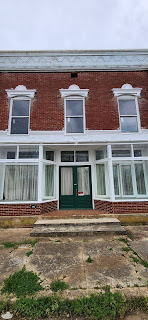Appomattox, Virginia
It was a wonderful week in Appomattox, Virginia. I am excited to stay for this week as well. We did have a couple of very windy days, almost 30mph. The RV was a swaying back and forth like we were on a boat. Haven't really had that strong of wind since Oklahoma.
How we were greeted when we came into the campground.
Enjoyed this view while we set up.
Our site for two weeks.
Last Sunday, we went to the town of Pamplin, Virginia. It is a ghost town with only 142 (2021 census) people live here. It was great to see the old buildings. It isn't exactly known when the beginnings of a settlement occurred in this area, but it was well before 1854, the year it was renamed Pamplin City. According to some public records, Merriman's Shoe Shop appears as early as 1820. Due to the number of eighteenth-century houses, it is safe to assume that this area has been a community since the late 1700's.
The old train depot. In the late 1990's a renewed emphasis on both history and
future Pamplin brought some grants obtained through several State and Federal
sources to renovate the former N&W railroad depot. It is now the home to the Pamplin
Town Office and also offers a large meeting/event room for community gatherings.
August 8, 1844, Nicholas Calvin Pamplin purchased twenty-nine acres of land that was in Charlotte and Prince Edward Counties (now known as Appomattox County). In 1854, a representative of the Norfolk and Western Railroad came to Merriman's Shoe Shop seeking land for a projected rail system. Mr. Pamplin, when approached, donated a large tract of land to the enterprise realizing the potential benefit to the village. In recognition of Mr. Pamplin's foresight and generosity, he was later honored by having the town named for him. Pamplin became a 19th century railroad boom town with such poise and expectations that official name of the immunity was made "Pamplin City". Hotels, banks, and various types of stores lined Main Street while fashionable homes were built throughout the town. However with the decline of rail travel, Pamplin's fortunes declined as well.
This building is for sale.
Starting to do some renovations in town.
This Baptist church was built in 1859.
Pamplin Pipe Factory was built in 1880. Once the largest producer of clay smoking pipes
in the world. This facility produced one million pipe per month in the heyday.
Wilmer McLean's purchased this home in 1862.
One of the bedrooms in the house.
This is the room where Lee surrendered to Grant.
The outside of the kitchen.
Outside of the slaves quarters.
Inside of the slaves quarters.
Outside of the ice house.
Inside the ice house.
We didn't see all of the buildings in the village, but plan to go back today after we visit the Confederate Museum.
It was a nice day to visit the cemetery.
Tuesday, we went to the Confederate Cemetery. I am not sure what hubby and I were expecting it would be like when we drove past, but when we got there, it wasn't what I was thought it would look like. The little cemetery holds nineteen soldiers (18 Confederate and 1 Union) buried in it. On May 18, 1866, a Ladies' Association was formed to ensure proper burials for soldiers who didn't receive one. The land was donated by Mr. John Sears, and the land clearing began. Most of the wood was donated for the coffins and the men built them and dug the graves.
The Ladies' Association later developed into the Untied Daughters of the Confederacy.
It was chartered on August 22, 1895 and have been maintaining the cemetery since 1866.
They hold a ceremony to honor the soldiers every 2nd Sunday
in April, unless it falls on Easter.
Only eight out of 19 soldiers were identified.
Confederate cannon.
Historical Site Marker.
"Keeping it real," hubby and I started talking about the Civil War, how it started and what was going on at that time. I know I studied it in school, but I did some research and thought I would share it with you, just in case you needed a refresher.
On the battle field.
Looks like a very hard life for our men.
"I believe this Government cannot endure, permanently half slave and have free." Abraham Lincoln.
On the evening of April 14, 1865, John Wilkes Booth, a famous actor and Confederate sympathizer, assassinated President Abraham Lincoln at Ford’s Theatre in Washington, D.C. The attack came only five days after Confederate General Robert E. Lee surrendered his massive army at Appomattox Court House, Virginia, effectively ending the American Civil War.
Abraham Lincoln and John Wilkes Booth.
Another new state! Here are the state bird, tree, flower and motto for Virginia.
*Virginia: Northern Cardinal (Bird), Flowering Dogwood (Tree), Flowering Dogwood (Flower), and Sic semper tyrannis is Latin for "tyrannical leaders will inevitably be overthrown". (Motto).
*Virginia: Northern Cardinal (Bird), Flowering Dogwood (Tree), Flowering Dogwood (Flower), and Sic semper tyrannis is Latin for "tyrannical leaders will inevitably be overthrown". (Motto).
Interesting that Virginia's state tree and flower are the same, Dogwoods are very pretty.
"For you will go out with joy and be led forth with peace; The mountains and the
hills will break forth into shouts of joy before you, and all the trees of the field
will clap their hands." Isaiah 55:12 (NASB)
Thank you for joining us on our journey! We are blessed to be able to share with you all that the Lord has shown us. May He shine His face upon you and yours this week.
If there is something special you would like me to take a picture of, please let me know!
Drop a comment for me and let me know your thoughts on the blog.
God, the RV & me...
Drop a comment for me and let me know your thoughts on the blog.
God, the RV & me...






























Comments
Post a Comment